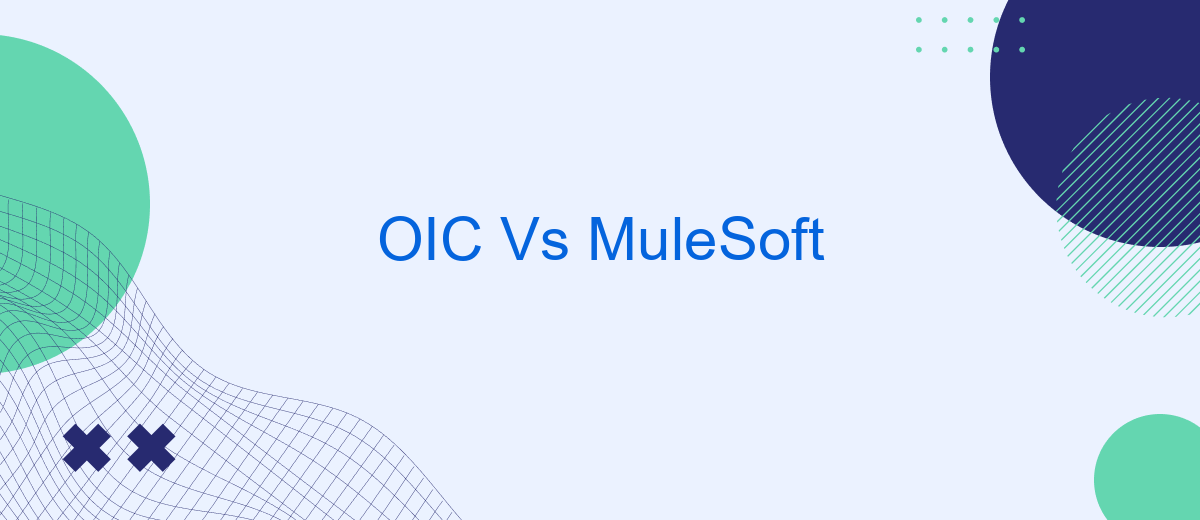In today's rapidly evolving digital landscape, businesses require robust integration platforms to streamline operations and enhance connectivity. Two leading solutions in this domain are Oracle Integration Cloud (OIC) and MuleSoft. This article delves into a detailed comparison of OIC vs MuleSoft, evaluating their features, capabilities, and suitability for various organizational needs, helping you make an informed decision for your enterprise integration strategy.
Introduction
In today's rapidly evolving digital landscape, businesses are increasingly relying on integration platforms to streamline their operations and enhance connectivity between disparate systems. Two prominent players in this domain are Oracle Integration Cloud (OIC) and MuleSoft. Both platforms offer robust solutions for integrating various applications and services, but they cater to different needs and preferences.
- Oracle Integration Cloud (OIC): Known for its comprehensive suite of tools and pre-built integrations, OIC is designed to simplify complex processes and accelerate digital transformation.
- MuleSoft: Renowned for its flexibility and extensive API management capabilities, MuleSoft provides a versatile platform for building and managing APIs, making it a favorite among developers.
- SaveMyLeads: This service offers a user-friendly interface for automating lead management and integration processes, helping businesses connect their CRM systems with various marketing tools effortlessly.
Choosing the right integration platform depends on various factors, including the specific needs of your business, the complexity of your IT environment, and your long-term strategic goals. This article will delve into the features, advantages, and use cases of OIC and MuleSoft, helping you make an informed decision. Whether you are looking for a comprehensive integration suite or a flexible API management solution, understanding these platforms will guide you towards the best choice for your organization.
Key Features

Oracle Integration Cloud (OIC) and MuleSoft are renowned for their robust integration capabilities, each offering a suite of key features tailored to different business needs. OIC provides a comprehensive platform with pre-built adapters, low-code automation, and AI-driven insights, making it an ideal choice for enterprises looking to streamline their integration processes. Its ability to connect various Oracle and third-party applications ensures seamless data flow and operational efficiency.
MuleSoft, on the other hand, excels with its API-led connectivity approach, enabling businesses to build reusable APIs and integrations. Its Anypoint Platform offers extensive tools for designing, building, and managing APIs, fostering a scalable and agile integration environment. Additionally, services like SaveMyLeads can complement these platforms by providing easy-to-use, automated workflows for lead management, further enhancing the integration capabilities of both OIC and MuleSoft.
Similarities

Both OIC (Oracle Integration Cloud) and MuleSoft are powerful integration platforms that help businesses streamline their processes and connect various applications seamlessly. They offer a variety of tools and features that simplify the integration process, making it easier for companies to manage their data and workflows effectively.
- Both platforms support a wide range of connectors that allow integration with popular applications and services.
- They provide robust security features to ensure the safe transfer of data between systems.
- Both OIC and MuleSoft offer user-friendly interfaces that make it easy for users to design, build, and manage integrations.
- They support real-time data processing, which is crucial for maintaining up-to-date information across systems.
- Both platforms have strong community and vendor support, ensuring that users can find help and resources when needed.
In addition to these similarities, services like SaveMyLeads can further enhance the integration capabilities of both OIC and MuleSoft by providing pre-built connectors and automation tools. This can significantly reduce the time and effort required to set up and maintain integrations, allowing businesses to focus on their core activities.
Differences

Oracle Integration Cloud (OIC) and MuleSoft are two prominent integration platforms, each with its unique strengths and features. OIC is known for its seamless integration with Oracle applications and cloud services, making it an ideal choice for businesses heavily invested in Oracle ecosystems. MuleSoft, on the other hand, is recognized for its versatility and ability to connect a wide range of applications, data sources, and APIs, regardless of the underlying technology.
One key difference between OIC and MuleSoft is their approach to integration. OIC offers pre-built adapters and a user-friendly interface, simplifying the integration process for Oracle users. MuleSoft provides a more flexible and developer-centric platform, with extensive customization options and support for various integration patterns.
- Integration Focus: OIC specializes in Oracle ecosystems, while MuleSoft supports a broader range of technologies.
- User Experience: OIC offers a more intuitive interface, whereas MuleSoft caters to developers with its robust customization capabilities.
- Pre-built Adapters: OIC provides numerous pre-built adapters for Oracle applications, whereas MuleSoft offers a wide array of connectors for diverse systems.
For businesses looking for an easy-to-use integration solution, SaveMyLeads offers a compelling alternative. It enables seamless automation of lead data between various platforms, reducing manual work and enhancing efficiency. While OIC and MuleSoft are powerful tools, SaveMyLeads stands out for its simplicity and effectiveness in automating lead management processes.
Conclusion
In conclusion, both OIC and MuleSoft offer robust solutions for integration needs, each with its own strengths and weaknesses. OIC is often praised for its user-friendly interface and seamless integration with Oracle products, making it a preferred choice for businesses already invested in the Oracle ecosystem. On the other hand, MuleSoft stands out for its versatility and extensive library of connectors, which cater to a wide range of applications and services.
Choosing between OIC and MuleSoft ultimately depends on your specific business requirements and existing technology stack. For those looking to simplify the integration process further, services like SaveMyLeads can be invaluable. SaveMyLeads provides an easy-to-use platform for automating lead data transfers between various applications, reducing manual work and enhancing efficiency. By carefully evaluating your needs and leveraging the right tools, you can achieve seamless and effective integrations tailored to your business objectives.
FAQ
What are the main differences between OIC and MuleSoft?
Which platform is better for integrating with non-Oracle applications?
Can both OIC and MuleSoft handle real-time data integration?
Are there any low-code options available for these platforms?
How can I automate integration tasks without deep technical knowledge?
What do you do with the data you get from Facebook lead forms? Do you send them to the manager, add them to mailing services, transfer them to the CRM system, use them to implement feedback? Automate all of these processes with the SaveMyLeads online connector. Create integrations so that new Facebook leads are automatically transferred to instant messengers, mailing services, task managers and other tools. Save yourself and your company's employees from routine work.
